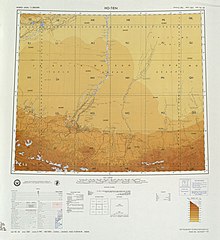Rawak Stupa
Rawak (Chinese: 热瓦克佛寺遗址) is a Buddhist stupa located on the southern rim of the Taklamakan Desert in Xinjiang, China, along the famous trade route known as the Silk Road in the first millennium Kingdom of Khotan.
[1] The site is now about 40 km north of the modern city of Hotan (Chinese: 和田) in Xinjiang Autonomous Region, China.
The form follows a scriptural description found in the Divyavadana, that describes a stupa as having four staircases, three platforms and an egg-like dome, as well as the other usual elements.
[7] Rawak is dated by several scholars to the fourth to fifth centuries, supported by finds, including coins, and stylistic considerations of the statues in the rectangular ambulatory, but also suggested by features such as the relic chamber placed high in the dome.
Stein suggested a possible late third to early fourth century date, based on the style of the stupa itself and the sculptures and paintings.



